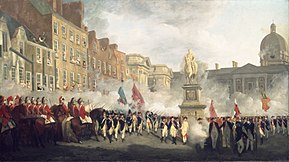
The Volunteers (also known as the Irish Volunteers) were local militias raised by local initiative in Ireland in 1778. Their original purpose was to guard against invasion and to preserve law and order at a time when British soldiers were withdrawn from Ireland to fight abroad during the American Revolutionary War and the government failed to organise its own militia.[1] Taking advantage of Britain's preoccupation with its rebelling American colonies, the Volunteers were able to pressure Westminster into conceding legislative independence to the Dublin parliament.[2][3] Members of the Belfast 1st Volunteer Company laid the foundations for the establishment of the United Irishmen organisation.[4] The majority of Volunteer members however were inclined towards the yeomanry, which fought and helped defeat the United Irishmen in the Irish rebellion of 1798.[1][5]
According to Bartlett, it was the Volunteers of 1782 which would launch a paramilitary tradition in Irish politics; a tradition, whether nationalist or unionist, that has continued to shape Irish political activity with the ethos of "the force of argument had been trumped by the argument of force".[6] Irish republicanism an offspring of the Volunteers of 1782, owes much to influences of both the American and French revolutions.[7]
- ^ a b Blackstock, Allan (2001). Double traitors?: the Belfast Volunteers and Yeomen, 1778–1828. Ulster Historical Foundation. p. 2. ISBN 978-0-9539604-1-5. Retrieved 3 October 2009.
- ^ Garvin, Tom (1981). The Evolution of Irish Nationalist Politics. Gill and Macmillan Ltd. p. 20. ISBN 0-7171-1312-4.
- ^ Cite error: The named reference
Liz Curtis1was invoked but never defined (see the help page). - ^ Cite error: The named reference
Bardonpg217-220was invoked but never defined (see the help page). - ^ Ulster Museum, History of Belfast exhibition
- ^ Bartlett, Thomas (2010). Ireland: A History. Cambridge University Press. p. 190. ISBN 978-0-521-19720-5.
- ^ Harmon, Maurice (1968). Fenians and Fenianism. Scepter Publishers Limited. p. 65. ISBN 978-0-295-95074-7.
